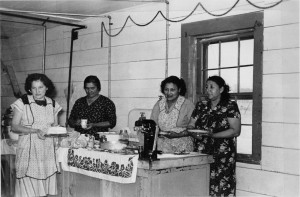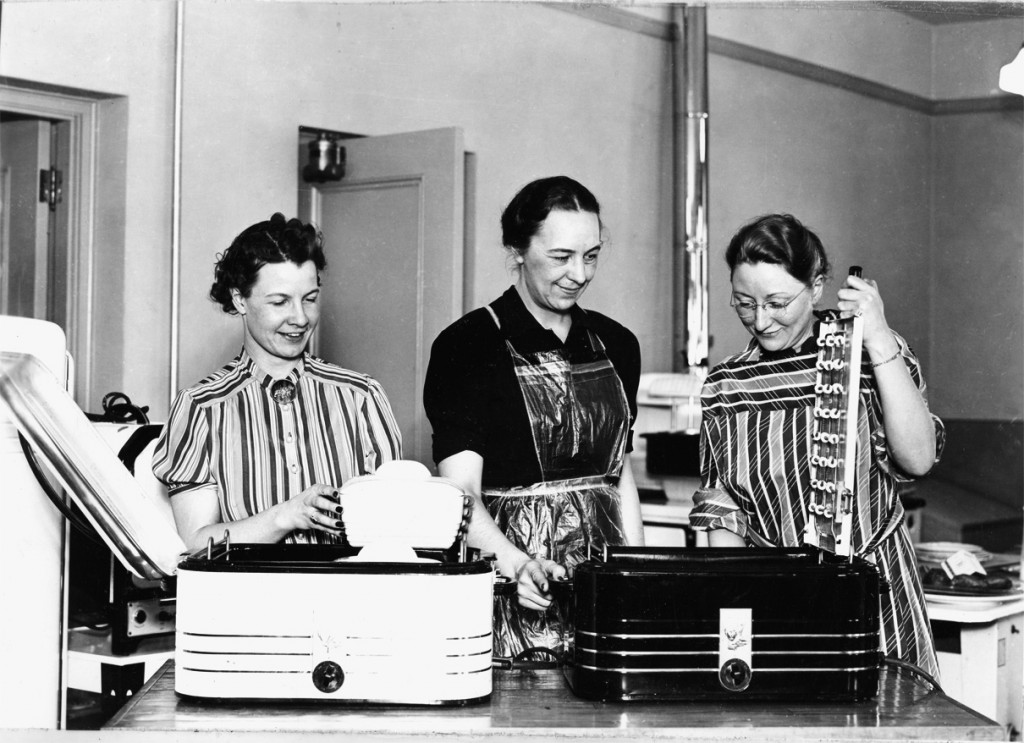
Home Demonstration clubs—also known as Homemakers clubs—were created in 1914 as part of the Cooperative Extension Service in Agriculture and Home Economics. Their goal was to bring “expert” instruction on the subjects of home economics and agriculture to rural women. Originally intended to “uplift” rural women through professional instruction, Home Demonstration clubs became a way for Montana women to socialize and learn from one another and to serve their communities. While the clubs attempted to reinforce conservative domestic values, the experiences of Home Demonstration clubwomen in the post-World War II era suggest that farm women adapted them to their own ends.
At their inception, Homemakers clubs reflected a Progressive-era faith that expertise and government intervention could improve American society. Targeting women who were unable to attend college, Home Demonstration agents instructed women in “scientific” methods of child rearing, food preservation, cooking, consumerism, nutrition, women’s and family health, and home and farm management. Department of Agriculture employee Mary E. Creswell expressed optimism that proper instruction would improve the lives—and character—of rural women: “With increased opportunity for training, . . . and with the opportunity for permanent service in her county, the work of the county woman agent will continue to be the most potent influence for progressive and happy country homes.”
Home Demonstration clubs became especially popular in Montana after World War II, in part because Montana women were seeking such expert advice. Alene Stoner of Great Falls said that she and other “young and new mothers” enrolled because “we just thought maybe the Extension Office could teach us some things, and we’d have fun doing it as a group.” Other women who participated pointed out that much of this “expert” instruction offered nothing new for rural women. Margaret Bradley of Richland County recalled that the meetings included “a lot of stuff we already knew. . . . Well, town people probably didn’t know much about the gardening and canning . . . like country people would have known.”

Rather than joining Home Demonstration clubs to gain new knowledge, women like Bradley reshaped the clubs into female spaces for socializing and community outreach. Club members sent flowers to people who were hospitalized, fund-raised for charities fighting polio and tuberculosis, sent money to Shodair Children’s Hospital in Helena, and volunteered for Red Cross blood drives. The clubs were also valuable for women looking to gather together and share domestic knowledge. Doris Goebel of Sidney explained, “[A]t that time that was our support, really. You know when you are raising little kids, if you had problems, why you’d talk to other homemakers.” The sense of community that the clubs provided proved more important than the instruction that agents offered. As Betty Norby of the Girard Homemakers Club put it, “It was just a special time.”
According to historian Amy McKinney, Montana’s Home Demonstration clubwomen defied post-World War II gender stereotypes. The ideal for 1950s women was one of a happy housewife, but agricultural women’s lives rarely resembled this Leave-It-to-Beaver stereotype. Rural women did, of course, cook, clean, and raise their children, but they were also intimately involved in the productive labor of the farm. They raised produce and chickens to sell in town, did the bookkeeping, and worked in the fields. According to McKinney, Home Demonstration instruction complemented farm and ranch women’s traditional role as economic participants in the family enterprise. Do-it-herself canning and sewing meant that less of the family income had to be spent on consumer goods.
Paradoxically, the postwar rise of agribusiness, increased farm mechanization, and the falling cost of consumer goods decreased the importance of women’s productive agricultural labor. To supplement their families’ incomes, increasing numbers of rural women took paid employment off the farm in the 1950s. This left less time for voluntary activities like the Home Demonstration clubs. By the 1960s club participation was falling. New economic realities spelled the end of that the “special time” during which clubs had served as an important space for building rural female communities. AH
To learn more about women’s work on rural farms and ranches, read “The Work Was Never Done: Farm and Ranch Wives and Mothers.”
Want to learn more? Read Amy McKinney’s article, “From Canning to Contraceptives: Cooperative Extension Service Home Demonstration Clubs and Rural Montana Women in the Post-World War II Era,” published in Montana The Magazine of Western History 61, no. 3 (Autumn 2011). You can find links to full text of all Montana The Magazine of Western History articles relating to women’s history here.
Sources
Creswell, Mary E. “The Home Demonstration Work.” Annals of the American Academy of Political and Social Science 67 (September 1916): 241-49.
McKinney, Amy. “From Canning to Contraceptives: Cooperative Extension Service Home Demonstration Clubs and Rural Montana Women in the Post-World War II Era.” Montana The Magazine of Western History 61, no. 3 (Autumn 2011): 57-70.
—. “How I Cook, Keep House, Help Farm, Too’: Rural Women in Post-World War II Montana.” Ph.D. dissertation, University of Calgary, 2011.
Mercier, Laurie K. “Montanans at Work: Businesswomen in Agricultural Communities.” Montana The Magazine of Western History 40, no. 3 (Summer 1990): 77-83.
—. “Women’s Role in Montana Agriculture: ‘You Had to Make Every Minute Count’.” Montana The Magazine of Western History 38, no. 4 (Autumn 1988): 50-61.